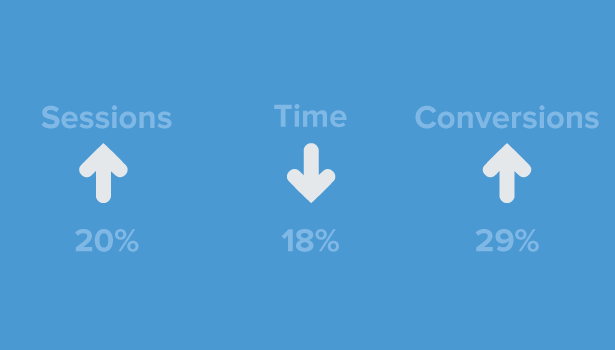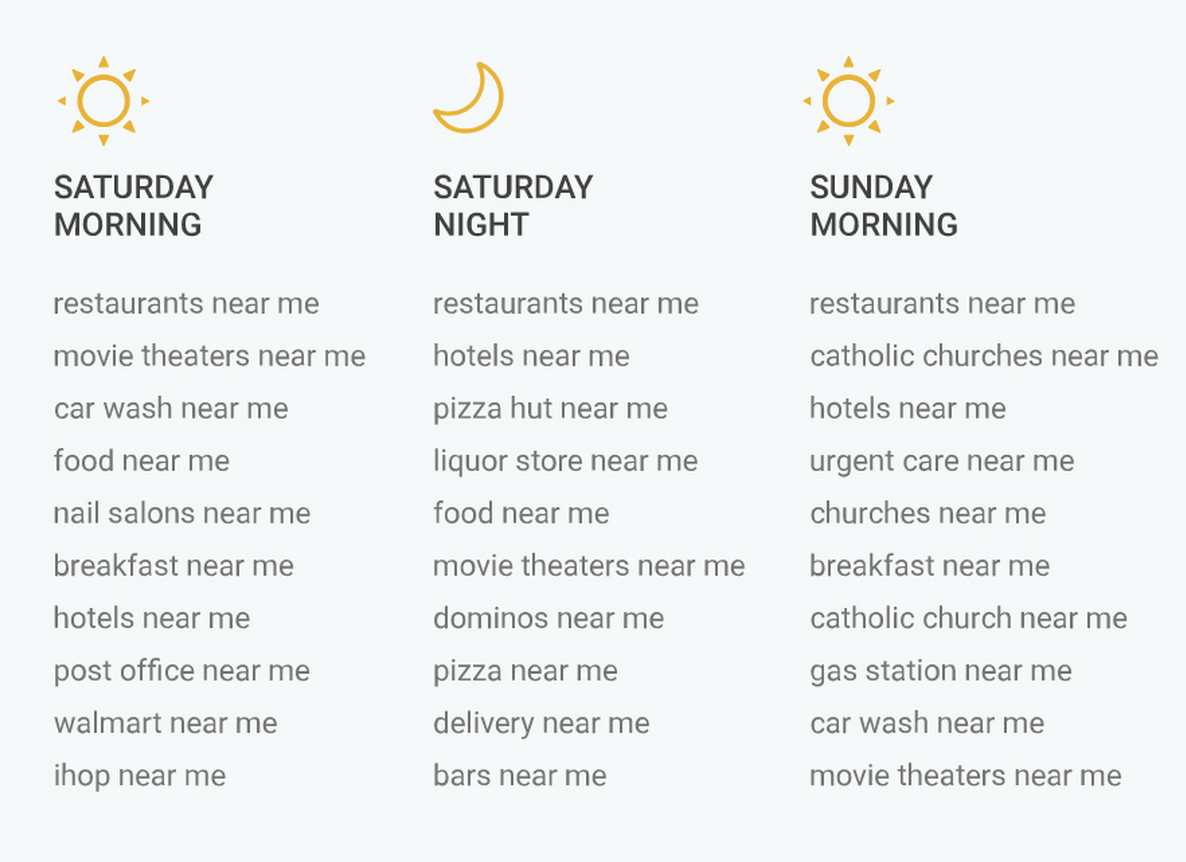
How to win on mobile: understanding micro-moments and consumer behavior

The mobile landscape has completely changed consumer behavior. Google released new research that has major implications for brands who want to win in an increasingly mobile world.
There’s no doubt that mobile is becoming more popular every year. In fact, mobile searches now outpace desktop searches in 10 countries, including the United States and Japan. In order to understand this trend we need to look at specific user behaviors.
Tens of millions of sites around the world use Google Analytics, and opt-in to allow their data to be aggregated and used for research. After analyzing all of that data, a few remarkable patterns emerged:
- Mobile sessions (visits to websites) have increased by 20% in the last year
- The amount of time spent per visit has decreased by 18%
- Yet at the same time, conversion rates on mobile have increased by 29%

That means our old mental model of web behavior is outdated. People no longer go online for long sessions of research and browsing. Instead, they go online in short bursts of activity (and do it more often). They find information in small, bite-sized chunks along a larger customer journey, and they make decisions faster than ever before.
Think about your own life: When you want learn, find, do, or buy something, you reach for the nearest device to you—it’s like a digital reflex. This is what we mean by "micro-moments." In these intent-rich moments, we’re actively reaching out for information to help us make better decisions.
The implications of micro-moments
UX designers really need to pay attention to micro-moments because, like Google’s Director of Performance Marketing Matt Lawson said, in these moments we’re “open to having our preferences shaped, and open to help with decisions we need to make along a journey to accomplish something.” The brands that are there to help us in these moments are the ones who are going to win our hearts, minds, and ultimately our dollars.
There were three insights from Google’s ethnographic research that really stood out: the importance of designing for immediacy, relevancy, and loyalty to needs. Let me explain:
- Immediacy of action: Because smartphones allow us to act on any impulse at any time, we do. We reach for our devices any time we want to learn, find, do, or buy something. And as a result, our expectations for immediate gratification have risen to a new high.
- Demand for relevancy: When we grab our phones and act on our impulse, we have high expectations and our patience tends to be low. Since we don’t have much time to browse and research, we immediately abandon anything that’s not relevant to us and move on to something else.
- Loyalty to personal needs: When you combine the heightened expectation for instant gratification and relevancy, people tend to be more loyal to their own personal needs and desires than they are to the brands they know and love.
The customer journey has changed
Mobile has fractured the customer journey into hundreds of micro-moments along the path to a buying decision. When people are on their mobile devices, they’re subconsciously wondering, “Am I getting what I want right now? Am I getting it in a way that’s accessible and useful to me?” And the brands who are there to satisfy the wants and needs of consumers are the brands who will win those moments.

Whether you’re a UX designer or a marketer, if you want to leverage these moments, you need to understand the larger context that your users operate within. The full customer experience doesn’t start when people land on your site or start using your tool. It starts when they’re sitting on their couch, riding on the train, walking down the street, and they have an idea.
Focus on mobile `behavior
When we talk about mobile, most of us tend to focus on technology: responsive sites, apps, etc. But as UX designers and marketers we need to take a step back and become digital psychologists and anthropologists. We need to get inside the heads of our customers and understand their behavior on mobile. This approach will get us the insights we need to create great experiences that get results.
In this article, I’m going to break down four micro-moments that Google discovered in their research. Each moment plays a decisive role in a much larger customer journey, and my goal is to give you insights you can use to gain a critical advantage on the mobile battleground.
(Note: Keep two things in mind: First, this is by no means an exhaustive list. There are plenty of micro-moments that still haven't been identified yet. Second, none of these moments are mutually exclusive. Sometimes user behavior demonstrates the characteristics of two or three micro-moments at the same time. Ok, let's get started.)
1. “I-want-to-know” moments
This is the moment when someone wants to know the answer to a question or find out a new piece of information that will help them make a decision. People make progress toward their big goals in small moments. Research shows that 90% of people who own smartphones have used them to make progress on a long-term goal or multi-step process while they were out and about. These "I-want-to-know" moments are often bite-sized pieces of research that are part of a much longer customer journey.
For example, when my wife and I first got married we were trying to decide which bank to use. There were so many options, and we wanted to know the difference between them all so we could make the best decision for our future. So we spent a month researching the details of credit cards, checking accounts, and savings accounts at a bunch of banks.

But we didn’t sit down and spend an entire weekend doing our research. Instead, we used “stolen moments” throughout the day: while we were waiting in line at the grocery store, riding the train, etc. After a long, considered process we decided to use one bank for our credit and checking accounts, and another bank for our savings account.
In their ethnographic research, Google interviewed a young woman named Erika who also used stolen moments to make progress toward her dream of buying a home in the near future. One day she was sitting in the airport waiting for her flight and decided to do some research. So she pulled out her phone and searched for “mortgage calculator,” where she found a site that helped her figure out what she could afford.
This wasn’t an isolated incident. Similar to my bank research, it was just one moment in a larger customer journey. Over a span of a few months she used her stolen moments—like when she was waiting to pick her kids up from soccer—to research a variety of homes, contractors, school districts, neighborhoods, and financing options, until she ultimately found the right choice for her family.
Key takeaways for “I-want-to-know” moments
- What do your users need to know? What are the questions that they’re asking?
- How can you be the most helpful to your users in the moment when they need to know something? How can you help them along their journey?
- It’s important to build a relationship with your audience throughout the entire customer journey. Do your research to understand what your users need, and create resources to meet those needs.
2. “I-want-to-do” moments
This is the moment when someone wants to do something and is looking for tools and resources to help them do it. 91% of smartphone users turn to their devices for ideas while doing a task. In "I-want-to-do" moments, people are open to help and your brand needs to be there for them.
For example, Danielle recently purchased a new baby carrier that she'd never used before. It didn’t have any straps or buckles, and she had a hard time figuring out how to get her kid into it. The day she was trying to figure it out, her internet connection wasn’t working so she couldn’t use her laptop. On top of that, her house was hot, her baby was crying, the dog was barking, and she really just needed to figure out how to safely get her baby into the carrier.
In this moment of chaos, she pulled out her phone and searched for instructions. She found a “how-to” video that showed her exactly how to put the carrier on, and how to safely put her baby in it.
Over 100 million hours of “how-to” content has been watched on YouTube so far this year, and YouTube searches related to "how to" are growing 70% year over year. More and more people are looking for how-to videos to help them with projects of all shapes and sizes. In these moments, they are actively asking for help and open to hearing from your brand.
Among the most popular “I-want-to-do” topics are home improvement, cooking, and beauty. Heidi Petz, VP of Marketing at top paint brand Valspar said, “Mobile is increasingly becoming the dominant way consumers access our content.” In order to win "I-want-to-do" moments, The Home Depot has built a content strategy to offer a wide range of home improvement videos.
Key takeaways for “I-want-to-do” moments
- Identify moments where users have a need and want to do learn how to do something.
- Talk to your customer support team to see which questions they get asked most frequently. If your brand consistently gets asked the same question, you need to answer it proactively.
- Provide helpful content to your customers even after the sale. The customer journey doesn’t end after the purchase, it’s an ongoing relationship and they still have needs you can serve.
- Offer instructions about how to do something difficult or confusing. Be there for customers in critical moments after the purchase. It can go a long way in building loyalty and driving advocacy.
3. “I-want-to-go” moments
This is the moment when someone decides that they want to go somewhere. So they pull out their phone and search for the location. People might search for a specific business, or they may just search to find what options are nearby.
Location based mobile searches are accelerating at a breakneck pace. “Near me” search queries have increased 34x since 2011. In fact, they doubled in the last year, and 80% of them came from mobile in Q4 of 2014.
After analyzing their analytics data, Google noticed that “near me” searches spike during the holidays and over the weekend—when people step out of their normal workday routines. Here were some of the most popular weekend location searches:
Top weekend “near me” searches

Source: Google Data, March 28-29, 2015.
What’s interesting about this data is that most of the top search terms are generic. Instead of searching for “Marriott hotels near me,” most people tend to search for “hotels near me." It seems that convenience and instant gratification are more important than being loyal to any specific brand in these moments.
But here's the thing: these moments are incredibly valuable. 50% of consumers who conduct a local search on their smartphone visit a store within a day.
And 18% of those searches lead to a purchase within a day.
So even though brand loyalty might not be the top priority for consumers in these moments, the brands that are there to serve them with an experience that’s fast, relevant, frictionless, and gives them what they want, are the brands that are going to win “I-want-to-go” moments.
Key takeaways for “I-want-to-go” moments
- How do users interact with your brand or category when they’re near your store?
- If they use generic search queries, do they find? Are you the go-to resource to in that moment? If not, what would make you the absolute best choice?
- Does your site or app make it easy for users to find local information such as directions, inventory, and pricing?
- Do you take the context of the entire customer journey into consideration when you make UX decisions?
4. “I-want-to-buy” moments
This is the moment when someone decides that they want to buy something, and they reach for their phone to make a purchase right there on the spot. These online purchases tend to happen in unexpected places. In fact, 39% of consumers have used their phone to make a purchase in their kitchen.
Google interviewed a woman named Cathy who broke her milk frother while she was doing the dishes. Without hesitation, she pulled out her phone and searched for “bodum milk frother” to find a replacement.
She found it on Amazon, read a few reviews, and made the purchase within five minutes. Just like that she had taken care of her problem and was able to move on with her day. She didn’t wait until later in the day to get on her desktop or go to the store.
Another interesting nuance of “I-want-to-buy” moments is that they can be influenced. Out of 4,468 online consumers age 18-34, one third of them say they found information online that caused them to buy a more expensive product if that product was more effective.
For example, Giana needed something at the pharmacy and had two choices. She opted for the more expensive one because she found a review on her smartphone said that it worked better.
People are often willing to pay a premium for higher quality products that get better results. And they also tend to look for product reviews to help them make the best purchase decision.
Key takeaways for “I-want-to-buy” moments
- When your customers search for product reviews to help their purchase decision, what information do they find?
- Provide relevant and useful information (like product reviews) when users are ready to make a purchase.
- Make buying on mobile fast and frictionless from start to finish. Get user feedback to make sure product pages are easy to find, and that your checkout workflow is painless.
Final thoughts
When people want to learn something, do something, go somewhere, or buy something, they reflexively reach for the nearest device, which is usually a smartphone. Instead of going online for long sessions of research, people browse the web in many short bursts of intent-rich activity. They do bite-sized pieces of research during “stolen moments” throughout the day—when they’re riding the train, waiting for their flight, or waiting in line at the grocery store.
Micro-moments are so important to UX designers and marketers because users have high intent, they're open to having their preferences shaped, and they’re also open to help with making decisions.
The brands who win these moments will be the ones who understand user behavior and deliver experiences that meet their needs. Here are some big picture ideas to help you craft your own mobile strategy:
- Identify the micro-moments that matter to your brand — In the context of mobile, when do consumers reach out to your brand and why?
- Deliver on user needs — Focus on people’s specific needs and behaviors within each micro-moment, and ask “How do we solve them?"
- Measure the moments that matter —Think about all the different paths that people can take to convert. They could begin the journey on one device and end it on another. They might convert on an app, or call your business. Or they might do some research on their smartphone and then walk into your store to make the purchase.
Sometimes purchases can happen across multiple devices, and users expect a seamless experience. In order to meet this need, it’s important to optimize for these moments across all devices—from mobile to desktop.





